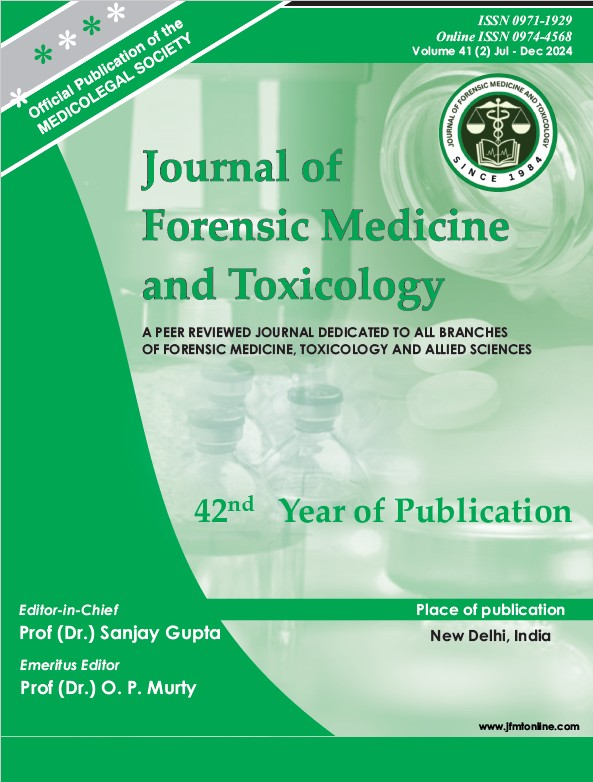Patterns of Histopathological Changes in Kidney in Phosphorus Poisoning- An Autopsy Finding
DOI:
https://doi.org/10.48165/jfmt.2025.42.3.21Keywords:
Yellow phosphorous, poisoning, histopathology, proximal tubular epithelial cells, glomeruliAbstract
Background Yellow phosphorus is a toxic, nonmetallic inorganic substance used in various sectors, such as fireworks, firecrackers, rodenticides, ammunition, match industries and fertilizers. We report a case of phosphorus poisoning with histopathological changes in the kidney. Case description An 18 years old male died from the consumption of rat poison (contains yellow phosphorous). On postmortem examination, yellowish discoloration was seen all over the body. Internal examination showed edematous brain. Yellowish discoloration with hemorrhagic areas was seen in the cerebellum along with yellowish discoloration of both liver and kidney. On histopathological examination of kidney, the proximal tubular epithelial cells were predominantly affected by diffuse cytoplasmic vacuolation. Glomerular epithelial cells showed cloudy swelling. No significant interstitial inflammation/tubulitis was seen.
Downloads
References
Nikkenen, H. E., & Ewald, M. B. (2006). Phosphorus. In: Flomenbaum N. E., Goldfrank L. R., Hoffman R. S., Howlans M. A., Neal A. L., Nelson L. S. (Eds.), Goldfrank’s Toxicologic Emergencies (pp. 1487–1497). McGraw-Hill.
Eldad, A., & Simon, G. A. (1991). The phosphorus burn—A preliminary comparative experimental study of various forms of treatment. Burns, 17(3), 198–200.
Brent, J., Wallace, K. L., & Burkhart, K. K. (2005). Phosphorus. In: Brent J., Wallace K. L., Burkhart K. K., Phillips S. D., Donovan J. W. (Eds.), Critical Care Toxicology – Diagnosis and Management of the Critically Poisoned Patient (pp. 851–861). Philadelphia, PA: Elsevier Mosby.
Here are your references separated and neatly formatted:
Ates, M., Dirican, A., Ozgor, D., Aydin, C., Isik, B., Ara, C., Yilmaz, M., Ayse Selimoglu, M., Kayaalp, C., & Yilmaz, S. (2011). Living donor liver transplantation for acute liver failure in pediatric patients caused by the ingestion of fireworks containing yellow phosphorus. *Liver Transplantation*, 17(11), 1286–1291.
Agency for Toxic Substances and Disease Registry. (1997, September). *Toxicological profile for white phosphorus.* Available from[http://www.atsdr.cdc.gov/toxprofiles/tp.aspid=285&tid=52(http://www.atsdr.cdc.gov/toxprofiles/tp.asp?id=285&tid=52)
Diaz-Rivera, R. S., Collazo, P. J., Pons, E. R., & Torregrosa, M. V. (1950). Acute phosphorus poisoning in man: A study of 56 cases. *Medicine (Baltimore)*, 29(4), 269–298.
Santos, O., Restrepo, J. C., Velasquez, L., Castano, J., Correa, G., & Sepulveda, E. *et al.* (2009). Acute liver failure due to white phosphorus ingestion. *Annals of Hepatology*, 8(2), 162–165.




